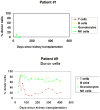Macrochimerism and clinical transplant tolerance
- PMID: 29330112
- PMCID: PMC5924711
- DOI: 10.1016/j.humimm.2018.01.002
Macrochimerism and clinical transplant tolerance
Abstract
Current theory holds that macrochimerism is essential to the development of transplant tolerance. Hematopoietic cell transplantation from the solid organ donor is necessary to achieve macrochimerism. Over the last 10-20 years, trials of tolerance induction with combined kidney and hematopoietic cell transplantation have moved from the preclinical to the clinical arena. The achievement of macrochimerism in the clinical setting is challenging, and potentially toxic due to the conditioning regimen necessary to hematopoietic cell transplantation and due to the risk of graft-versus-host disease. There are differences in chimerism goals and methods of the three major clinical stage tolerance induction strategies in both HLA-matched and HLA-mismatched living donor kidney transplantation, with consequent differences in efficacy and safety. The Stanford protocol has proven efficacious in the induction of tolerance in HLA-matched kidney transplantation, allowing cessation of immunosuppressive drug therapy in 80% of study participants, with the safety profile of conventional transplantation. In HLA-mismatched transplantation, multi-lineage macrochimerism of over a year's duration can now be consistently achieved with the Stanford protocol, with complete withdrawal of immunosuppressive drug therapy during the second post-transplant year as the next experimental step and test of tolerance.
Keywords: Chimerism; Hematopoietic cell transplantation; Immune tolerance; Kidney transplantation.
Copyright © 2018 American Society for Histocompatibility and Immunogenetics. Published by Elsevier Inc. All rights reserved.
Figures




References
-
- Owen RD. Immunogenetic consequences of vascular anastomoses between bovine twins. Science. 1945;102:400–401. - PubMed
-
- Burnet FM, Fenner F. The production of antibodies. Macmillan; Melbourne, Australia: 1949.
-
- Billingham RE, Brent L, Medawar PB. ‘Actively acquired tolerance’ of foreign cells. Nature. 1953;172:603–606. - PubMed
-
- Billingham RE, Brent L, Medawar PB. Quantitative studies on tissue transplantation immunity. III. Actively acquired tolerance. Phil Trans R Soc Lond B. 1956;239:357–414.
Publication types
MeSH terms
Substances
Grants and funding
LinkOut - more resources
Full Text Sources
Other Literature Sources
Medical
Research Materials

